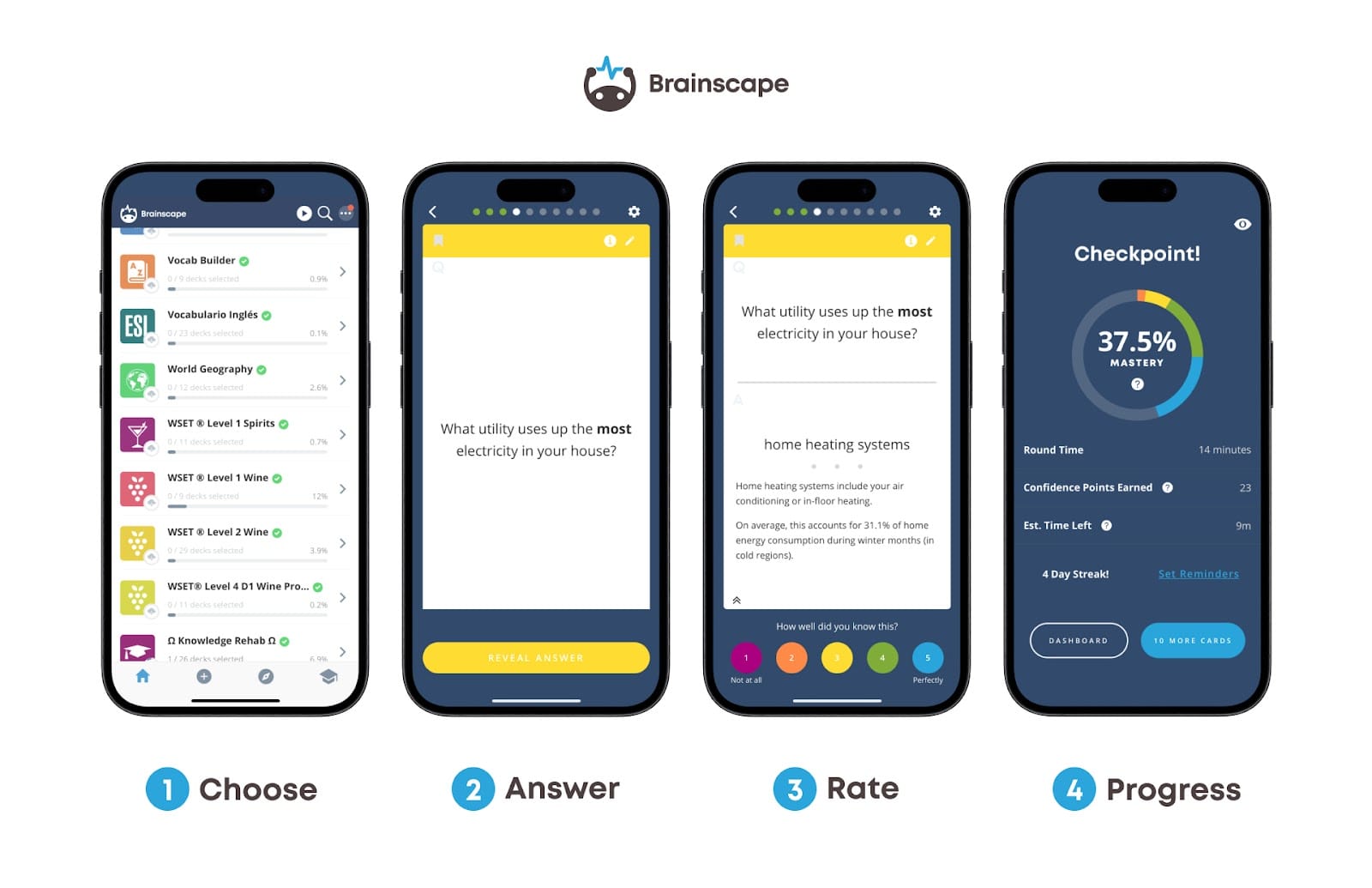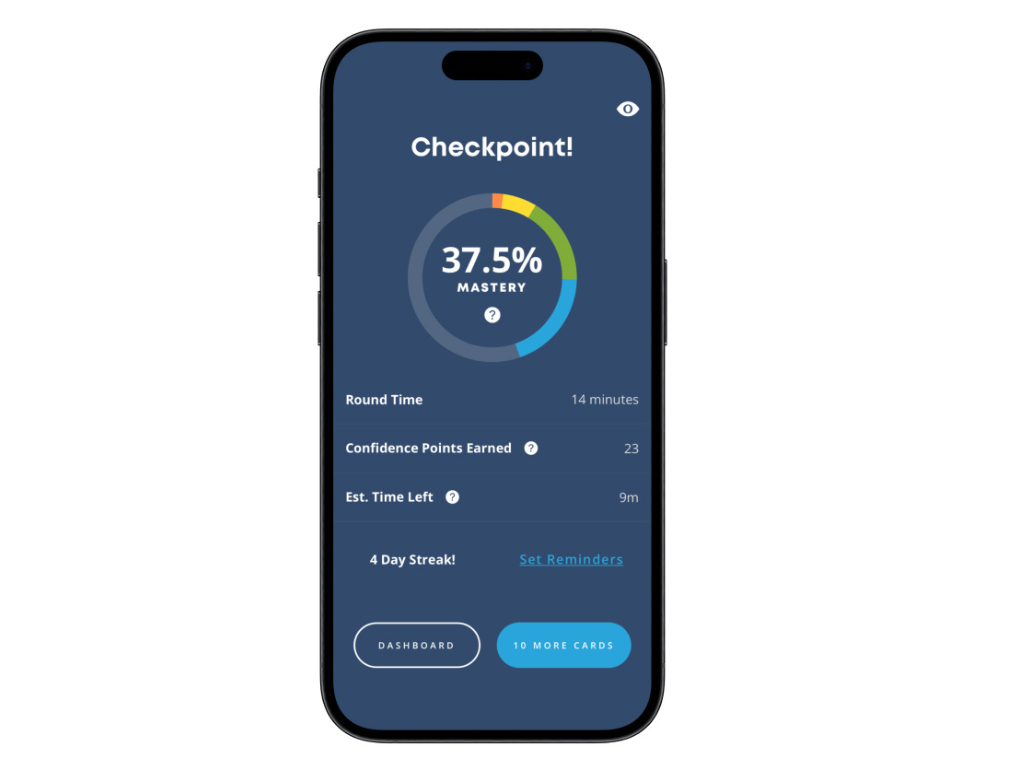You know you need to study for that test. You’ve blocked out time, poured yourself an obscene amount of coffee, and strewn your desk with textbooks and notes.
So why haven’t you actually started?
Getting started is often the hardest part of studying—especially when you're staring down a big exam. The good news? There’s a science-backed reason for this, and it’s called activation energy. It’s the invisible mental wall between intention and action, and it’s one of the biggest obstacles to building strong study habits and finding the motivation to study.
In this guide, we’ll show you how to study for a test or exam by lowering that activation energy—so you can stop procrastinating, start studying, and finally build the kind of momentum that leads to real learning gains.
What is Activation Energy?
In chemistry, activation energy is the initial energy required to start a reaction. It’s the spark that ignites the process. In psychology, the concept has been adapted to explain why it takes effort to begin any new task—even one we know is good for us. Like studying for a test or exam, or reviewing flashcards.
When it comes to building effective study habits, the hardest part is often just getting started. You don’t need a perfect plan or ideal conditions. You just need enough energy to begin. That’s what activation energy is all about: overcoming the resistance to starting so that studying feels less overwhelming and more automatic.
What’s the Science Behind Activation Energy (in Psychology)?
Research in behavioral psychology shows that once a task is initiated, it’s much easier to continue. This is partly due to the Zeigarnik effect, which suggests that we remember uncompleted tasks more vividly, creating a mental tension that nudges us to complete them.
In other words, starting creates its own momentum. And that momentum is key to learning how to study for exams without getting stuck in procrastination mode. Often, the biggest challenge in developing strong study habits isn’t the hours of reviewing material—it’s the first 60 seconds.
What are Examples of Activation Energy in Daily Life?
Mental inertia also, naturally, shows up in everyday life. Ever struggled to start a workout, clean your apartment, or reply to that one annoying email? You’re not lazy—you’re just battling activation energy.
Our brains tend to resist anything that requires upfront effort, even when the long-term rewards are totally worth it. That’s why simple tasks like organizing your notes, reviewing flashcards, or creating a study plan can feel harder than they actually are.
This mental resistance is the same force that makes it tough to find the motivation to study—especially when you're preparing for a big test or exam. The key is learning how to start studying without overthinking it. Once you begin, momentum (and confidence) tends to follow.
What’s the Relationship Between Activation Energy & Procrastination
Procrastination is the ultimate activation energy problem. It thrives on delay, indecision, and distraction.
You might have the best intentions, but when the moment comes to sit down and study, your brain goes looking for easier wins like snacking, napping, or browsing the apps. It’s not that you lack the motivation to study. It’s that the cost of starting feels too high.
To overcome procrastination, we need to lower the mental cost of taking that first step. We’re going to help you do that right now by (1) examining the barriers to effective study habits and (2) discuss the many strategies for overcoming them.
What are the Barriers to Starting Studying for a Test?
Before we can reduce activation energy, we need to understand what raises it. Common culprits include:
- Overwhelming goals ("I need to study everything for the midterm.")
- Perfectionism ("I can’t study until my workspace is spotless.")
- Unclear starting points ("I don’t know where to begin.")
- Low energy or distractions ("It’s easier to rot in bed on TikTok.")
- Negative self-talk ("I’m so behind because I’m such a lazy loser.")
Each of these creates friction that blocks solid study habits from forming. But the good news?
They’re all fixable.
How to Start Studying: 6 Ways to Beat Activation Energy
The goal isn’t to eliminate the effort of studying—it’s to make starting feel effortless. If you’re wondering how to study for a test when motivation is at rock bottom, these simple strategies can help reduce activation energy and get you going.
1. Shrink the Task
Break studying into tiny, manageable actions: open your laptop. Open your notes or flashcard app. Review just 10 flashcards. That’s it. These micro-starts lower the psychological barrier and make it easier to build lasting study habits.
2. Use Visual Triggers
Leave your notes open. Place your textbooks in plain sight. Add calendar reminders or sticky notes. These subtle cues in your environment can nudge you into action—no willpower required.
3. Set a Timer for 15 Minutes
Commit to studying for just 15 minutes. That’s it. Set a timer, and once it goes off, you’re free to stop. But here’s the trick: once you’ve started, it’s usually easier to just keep going. This technique builds momentum and helps overcome the initial resistance.
4. Create a Study Ritual
Start every session with the same simple routine: a 5-minute review, a deep breath, or your go-to study playlist. Repetition helps your brain shift gears into “focus mode” faster and with less friction.
5. Pair Study with Pleasure
Reward yourself with a snack, a walk, or a social scroll after short bursts of studying. The brain craves dopamine, and these small, positive incentives reinforce motivation to study over time.
6. Use Tools That Make It Easy to Start
This is where Brainscape comes in…
Brainscape: The Lowest Activation Energy in Studying
Brainscape is a flashcard study app that was built for learners who struggle with that dreaded first step. With just a single click or tap of the study button, you’re instantly transported into the heart of your studies—exactly where you left off. And this pretty much eliminates the pain of getting started. No complicated setup, no mental gymnastics required.

Also, making flashcards is fun… but even better, the app’s sophisticated toolbox of AI features allows you to make flashcards in seconds from any Word doc, PowerPoint, Excel spreadsheet, or even photos of your textbook or study notes. This allows you to distill your learning materials into a complete set of flashcards that you can study anytime, anywhere, immediately.
The real “secret sauce” lies in Brainscape’s study algorithm, which leverages decades of cognitive science research to help you learn faster, get motivated, and build strong study habits. What this means is that even just five minutes of review lead to much more meaningful progress.
In short, Brainscape takes the guesswork out of how to start studying, helping you build consistency through simple, smart, science-backed design.

How To Use Brainscape to Start Studying for Exams: Real-Life Examples
Let’s make this concrete. Imagine these scenarios:
- You open your notes and feel overwhelmed. Instead, you open Brainscape and study 10 flashcards. Now, your brain is warmed up and ready to dive deeper. You keep going and before you know it, 20 minutes has gone by, you’ve reviewed 40 flashcards and improved your mastery.
- You tell yourself you’ll study later, then keep putting it off. Instead, you set a 10-minute timer and review just one topic in your textbook. Once you’ve read the section, you’re inspired to write notes or make flashcards for it. That quick win often leads to a full study session.
- You’re on your commute or stuck in a waiting room. Instead of doom scrolling social media, you open Brainscape and sneak in two flashcard study rounds before you reach your stop or the doctor calls you in. That’s quality learning you just snuck into time you would have otherwise squandered.
These aren’t hacks. They’re just smarter ways to reduce activation energy so that studying becomes a habit, not a hurdle.
FAQ: How to Use Social Motivation to Study
How do I Study When I Have Zero Motivation?
Start by lowering the activation energy. Shrink your tasks! Review five flashcards, set a 10-minute timer, or read one paragraph. Once you begin, momentum builds naturally. Using a tool like Brainscape can make it easier to take that first step and turn zero motivation into steady progress.
Why Do I Have No Motivation to Study for Exams?
Lack of motivation is often tied to overwhelm, burnout, unclear goals, or perfectionism. If the task feels too big or the starting point isn’t obvious, your brain resists it. By breaking the task into smaller steps and removing friction, you can reduce that mental resistance and get back on track.
How Can I Study With ADHD and No Motivation?
Start by creating a low-friction study environment. Minimize distractions, use timers (like the Pomodoro method), and break your study session into short, manageable bursts. Brainscape’s adaptive flashcards are ideal for ADHD learners—they offer structured, bite-sized bits of information that are easy to start and easy to stick with.
The Final Push: Study Smarter by Starting Smaller
Everyone wants to do well on exams. Everyone wants to master tough material. But too often, there’s a wide gap between our intentions and our actual study habits.
That’s where the science of activation energy comes in. It reminds us that the first few seconds matter most—and that if you can just get over the hump, you’re already halfway there.
That’s also what makes tools like Brainscape so powerful. Our smart flashcards give you a shortcut to action. Open the app, review a few cards, and you’re instantly in motion. And once you're in motion, real learning follows.
So the next time you’re stuck, remember: the hardest part isn’t finding the motivation to study for a test—it’s lowering the resistance to starting.
By understanding activation energy and using these strategies to start studying, you’ll finally be able to build the consistent study habits that lead to long-term success. Whether you're preparing for a test, an exam, or any big academic goal, the key is simple: start small, and start now.
Additional Reading
- How to Use Social Motivation to Study
- How Study Metrics Can Save You From Procrastination
- How to Build Strong Study Habits
References
Deemer, E. D., Derosa, P. A., Duhon, S. A., & Dotterer, A. M. (2019). Psychological momentum and inertia: Toward a model of academic motivation. Journal of Career Development, 48(3), 275–289. https://doi.org/10.1177/0894845319848847
Kalmakov, O. A. (2024). Daring Activation Energy: Environmental Design for Accelerated Learning and Intrinsic Motivation in Primary Education. https://doi.org/10.21203/rs.3.rs-5592398/v1
Kori, K., Pedaste, M., Altin, H., Tonisson, E., & Palts, T. (2016). Factors that influence students’ motivation to start and to continue studying information technology in Estonia. IEEE Transactions on Education, 59(4), 255–262. https://doi.org/10.1109/te.2016.2528889
Ongchoco, J. D., Wong, K. W., & Scholl, B. (2023). The “unfinishedness” of dynamic events is spontaneously extracted in visual processing: A new ‘visual zeigarnik effect.’ Journal of Vision, 23(9), 4974. https://doi.org/10.1167/jov.23.9.4974
